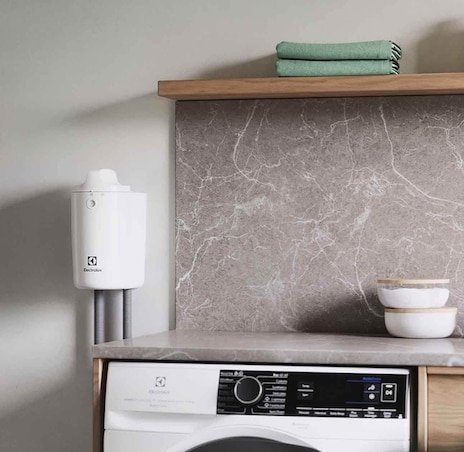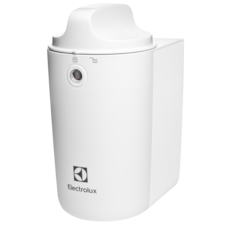An Electrolux innovation designed to protect the planet: microplastic filters
Did you know that microplastics released during machine washing of synthetic fabrics is increasingly becoming a serious environmental issue?
In response to the problem, Electrolux has developed a filter to capture microplastics released from washing machines to help prevent them flowing into our waterways, rivers, and oceans.

What does a microplastic filter do?
The Electrolux microplastic filter offers a solution that allows you to machine wash synthetic clothing while reducing their environmental impact. Installed on your laundry wall, the filter captures up to 90% of microplastic fibres larger than 45 microns released from synthetic clothing* during the machine-washing process. As a global leader in sustainable appliance design, the Electrolux filter is made from at least 50% recycled plastic content.
*Filtration capacity measured using an internal test with polycotton and polyester blend materials using the Synthetics cycle at 40°C.
![What are microplastics? Microplastics are defined as plastic particles smaller than 5mm. They are pollutants that do not biodegrade easily when released into an aquatic environment, causing significant damage to marine life. These particles are classified into primary and secondary microplastics. Synthetic microfibres are a sub-category of the microplastic family, covering a wide range of sizes (from approximately 3 to 30 micrometres [μm] in width) and primarily found in clothing and textiles, and also in transportation products such as tyres. They include various polymeric materials, including synthetics, semi-synthetics and natural products.](/contentassets/88710a09f2f147e180466862ad1bd25a/place-holder-1.png)
What are microplastics?
Microplastics are defined as plastic particles smaller than 5mm. They are pollutants that do not biodegrade easily when released into an aquatic environment, causing significant damage to marine life. These particles are classified into primary and secondary microplastics. Synthetic microfibres are a sub-category of the microplastic family, covering a wide range of sizes (from approximately 3 to 30 micrometres [μm] in width) and primarily found in clothing and textiles, and also in transportation products such as tyres. They include various polymeric materials, including synthetics, semi-synthetics and natural products.

Why microplastic fibres are released during the wash cycle
The main cause of the release of microplastics from synthetic clothes is the mechanical and chemical stress to which the fabrics are subjected during machine washing, which leads to the detachment of the microfibres from synthetic fabrics, such as polyester and nylon.
How much microplastic are released during a wash cycle?
To date, there is no formally documented quantity as there are many variables that need to be taken into consideration. Several initiatives around the world are currently taking action to evaluate the release of microplastics from fabrics from different perspectives: from the nature and structure of synthetics fabrics to machine washing conditions.
-
- Reduces release of microplastic fibres.
- Ensures eco-friendlier washing.
- Indicates when it’s time to clean filter.
-
- Filter reduces release of microplastic fibres.
- Microplastic Filters for eco-friendlier washing.
- Maintain easily with cleaning brush provided.

Easy installation
The microplastic filter is fitted on the wall next to your washing machine and can be installed on either side of the appliance. The filter is secured to the wall with screws and should be positioned at a height of 110cm, calculated from the top of the plate to the floor (or pedestal if present). Maintain at least 40 cm of space above the filter and 20cm either side, to facilitate ease of opening and prevent obstructions from walls or shelving.
-
How does the microplastic filtration process work?
The microplastic filter has a cartridge with a fine mesh filter to capture 90% of microplastic fibres larger than 45 microns which are released from synthetic fabrics during washing.
-
What is the impact of microplastics on the environment and human life?
The study of microplastics and their impact on the environment and human life is an emerging field. However, microfibres have been detected in all oceanic ecosystems. A recent study found that 73% of microfibre pollution in once pristine Arctic waters comes from synthetic fibres likely to have come from textiles.
-
What is the equivalent in plastic bags or bottles?
Over 50% of all textiles contain microplastic fibres. On average, a family washes 220 loads a year. So, even taking a more conservative 50% and applying it to wash cycles, it's safe to assume that at least 110 wash loads contain microplastic fibres released from synthetic fabrics. From Electrolux testing, the microplastics filter can capture an amount of microplastics almost equivalent to the amount of plastic contained in 1-2 plastic bags* each year per appliance.
*Assuming a weight of 5 g per shopping bag (Julien Boucher, Damien Friot – Primary Microplastics in the Oceans – IUCN 2017)
-
What does Electrolux aim to achieve with this microplastic filter?
Electrolux is a leading global appliance company that has been contributing to a better lifestyle for more than 100 years. By introducing this filter, we are encouraging as many people as possible to adopt more eco-positive machine washing practices. Installing a microplastic filter is a step we can all take to reducing the environmental impact from textiles.
-
How do I know when it’s time to clean the filter?
When the indicator turns red, it is time to clean the filter. Use the brush provided and dispose of the microplastic fibres. The cleaned filter cartridge can be used for 6 months before being replaced and recycled*. The filter must not be cleaned under running water.
*The cleaned filter can be recycled. When the filter is not cleaned properly it should go in the general household waste bin.
-
Is the Electrolux microplastics filter compatible with my washing machine?
The microplastic filter is compatible with all Electrolux front load washing machines, as well as AEG models, regardless of the age of the appliance.



